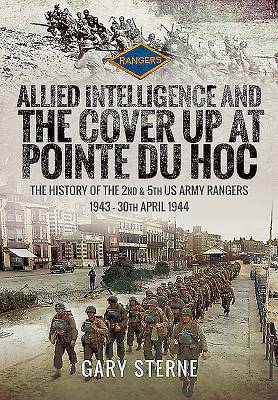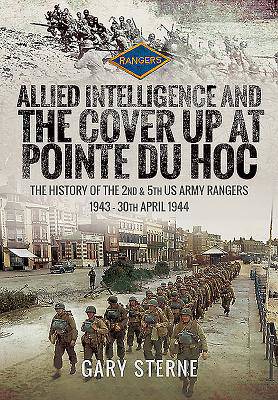
- Afhalen na 1 uur in een winkel met voorraad
- Gratis thuislevering in België vanaf € 30
- Ruim aanbod met 7 miljoen producten
- Afhalen na 1 uur in een winkel met voorraad
- Gratis thuislevering in België vanaf € 30
- Ruim aanbod met 7 miljoen producten
Zoeken
Allied Intelligence and the Cover Up at Pointe Du Hoc
The History of the 2nd & 5th US Army Rangers, 1943 - 30th April 1944
Gary Sterne
Hardcover | Engels
€ 48,95
+ 97 punten
Omschrijving
Volume 1 of this two-part work puts the reader firmly into the footsteps of the 2nd and 5th Rangers as they arrive in England in 1943. It follows them during their intensive training with the Commandos and the Royal Navy as they head towards D-Day - including cliff climbing, assault landings and the Slapton Sands 'dress rehearsal'.
The orders given to the Rangers, along with dozens of aerial reconnaissance photographs of Omaha Beach, Pointe et Raz de la Percée, Pointe du Hoc and Maisy - as well as French Resistance reports - detail the information given to the Rangers' commander Lt. Col. Rudder. Shown in chronological order and in their original format, many of the documents are still marked TOP SECRET and were only recently released after nearly 70 years.
The author fills in the gaps that many have only guessed at concerning the Rangers' real missions on D-Day, and in Volume 2 he explains why a battalion commander was removed whilst onboard ship prior to the landings, why the individual Rangers were not briefed on all of their D-Day objectives - as well as the extraordinary role that Lt. Col. Rudder played at Pointe du Hoc.
Described by US historians as 'one of the most detailed works about the D-Day Rangers ever written', this work is the culmination of four years of detailed research within the US Archives and backed up by evidence uncovered in Normandy. It is a real historical game-changer that pulls no punches as it challenges conventional studies of one of the most iconic battles of WWII.
There can be no doubt that this work will change the way that historians view the Pointe du Hoc battle from now on.
The orders given to the Rangers, along with dozens of aerial reconnaissance photographs of Omaha Beach, Pointe et Raz de la Percée, Pointe du Hoc and Maisy - as well as French Resistance reports - detail the information given to the Rangers' commander Lt. Col. Rudder. Shown in chronological order and in their original format, many of the documents are still marked TOP SECRET and were only recently released after nearly 70 years.
The author fills in the gaps that many have only guessed at concerning the Rangers' real missions on D-Day, and in Volume 2 he explains why a battalion commander was removed whilst onboard ship prior to the landings, why the individual Rangers were not briefed on all of their D-Day objectives - as well as the extraordinary role that Lt. Col. Rudder played at Pointe du Hoc.
Described by US historians as 'one of the most detailed works about the D-Day Rangers ever written', this work is the culmination of four years of detailed research within the US Archives and backed up by evidence uncovered in Normandy. It is a real historical game-changer that pulls no punches as it challenges conventional studies of one of the most iconic battles of WWII.
There can be no doubt that this work will change the way that historians view the Pointe du Hoc battle from now on.
Specificaties
Betrokkenen
- Auteur(s):
- Uitgeverij:
Inhoud
- Aantal bladzijden:
- 504
- Taal:
- Engels
Eigenschappen
- Productcode (EAN):
- 9781526752222
- Verschijningsdatum:
- 27/06/2019
- Uitvoering:
- Hardcover
- Formaat:
- Genaaid
- Afmetingen:
- 170 mm x 249 mm
- Gewicht:
- 1428 g

Alleen bij Standaard Boekhandel
+ 97 punten op je klantenkaart van Standaard Boekhandel
Beoordelingen
We publiceren alleen reviews die voldoen aan de voorwaarden voor reviews. Bekijk onze voorwaarden voor reviews.











